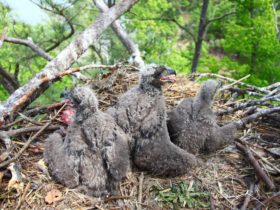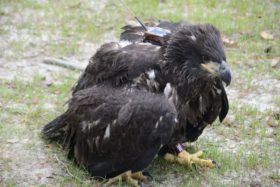AZ and CAM at Red Wing GC Together
Azalea Remains At Red Wing Golf Course May 27
May 28, 2011Camellia Still At Charity Neck May 30
May 31, 2011
Click on map to enlarge
Azalea and Camellia were together at Red Wing Golf Course in Virginia Beach on May 24, 25, 26. I have color coded their respective locations. The map shows that on May 24 they sat close together overnight (Pink-AZ and Blue-CAM dots) and May 26 (Green-AZ and Light Blue-CAM dots). The night of May 25 they were apart (Light Green-AZ and Orange-CAM dots). The yellow dot is an existing bald eagle nest with two eaglets.
Map key:
Azalea – ORANGE lines – WHITE dot location at 2:00pm May 27 – At 1:00am May 24 (PINK), May 25 (LIGHT GREEN) May 26 (GREEN)
Camellia – BLUE lines – At 1:00am May 24 (BLUE), May 25 (ORANGE), May 26 (LIGHT BLUE)




8 Comments
WOW! It is so exciting seeing how close together Azalea and Camellia are. Thank you, Reese, for posting and sharing your knowledge with so many. Why are the adults of the local nest with the two eaglets allowing AZ and Cam in their territory? Why are they not considererd as intruders to be excorted away? Those two being so close together really makes one wonder where their siblings are. Thanks again.
Response – There have been other juvenile eagles at Red Wing over the past few weeks, and I have seen others in past years there. It appears that the adults do not consider the juvies to be a threat, including Azalea and Camellia. You will also note that neither AZ or CAM show data points in the immediate area of the nest tree (Yellow data point). So they are not getting real close to the nest.
Thanks Reese. I believe Mom and Dad taught their kids well. They respect boundaries.
Give my regards to the Mrs. and have a nice weekend!
Good Evening REESE,
Great info on two of your own. It is always interesting to see where the eagles go now that they are flying on their own and can go anywhere they want. They seen to like to hang around together at times, family spirit. It was nice to have you on the eagle cam for a minute tonight, I am sorry that I missed you there. Your three are getting so big…..My best to the Mrs, and oh yea, Really, REALLY GREAT pictures of Mommy Norfolk, you captured her beauty so well.
Thank you so very much for sharing this information. It is amazing!
How exciting, Reese! Try as i might, i can’t see the light blue, light green, and green data points…but even failing that, it’s really clear that their paths are overlapping in space and time. I can also see that both of them are honoring a no-fly zone over the existing nest.
Thanks so much for all these maps and info! Reese, I recall reading that only 50% of eaglets make it through their first year. If this is true, then statistically only these two and one of their four ’09/’10 siblings have made it this far. But what are the odds that the two with transmitters would be two of the three to have survived that hard first year? I like to think Mom and Dad didn’t raise any dummies and perhaps our Norfolk juvies have had the right stuff to beat the odds and more than 3 of the 6 from 2009 and 2010 have survived.
Response – More accurate that 50% survive to maturity at 5 years of age rather than end of first year. Since there are no confirmed sightings of the other “four”, no way to know if they have survived so far. A purple banded eagle was seen recently in Jamestown, but not able to read the band number.
Curious as to how it is that Azalea and Camellia stay close by at times. A year apart, how do you explain that?? Is that partly due to imprinting? No sight of their other siblings yet. Just curious.
Response – We do not know if they “know” each other. Imprinting may explain in part why they occasionally are in the same location. Imprinting causes them to return to this area no matter where they wander off too. It is likely that they see another eagle soaring and fly to check it out. The “other” eagle sometimes just happens to be either Azalea or Camellia.
@GemKitten – We’ve tracked 20 nestling bald eagles from the Chesapeake Bay since 2007 and had >90% survival in the first year. A similar study of Chesapeake Bay bald eagles conducted in the 1980s had similar results. Survival rates are different in other parts of the species range. We’re pleased but not surprised Azalea and Camellia have survived their first year and appear to be doing well.